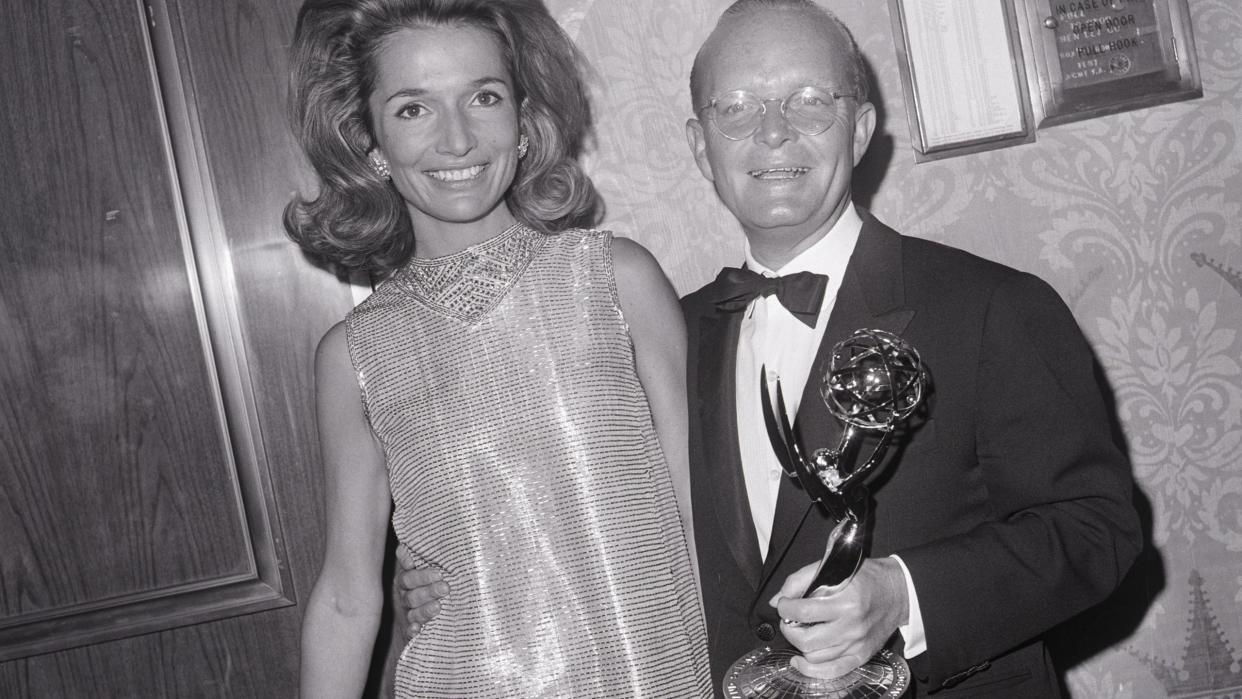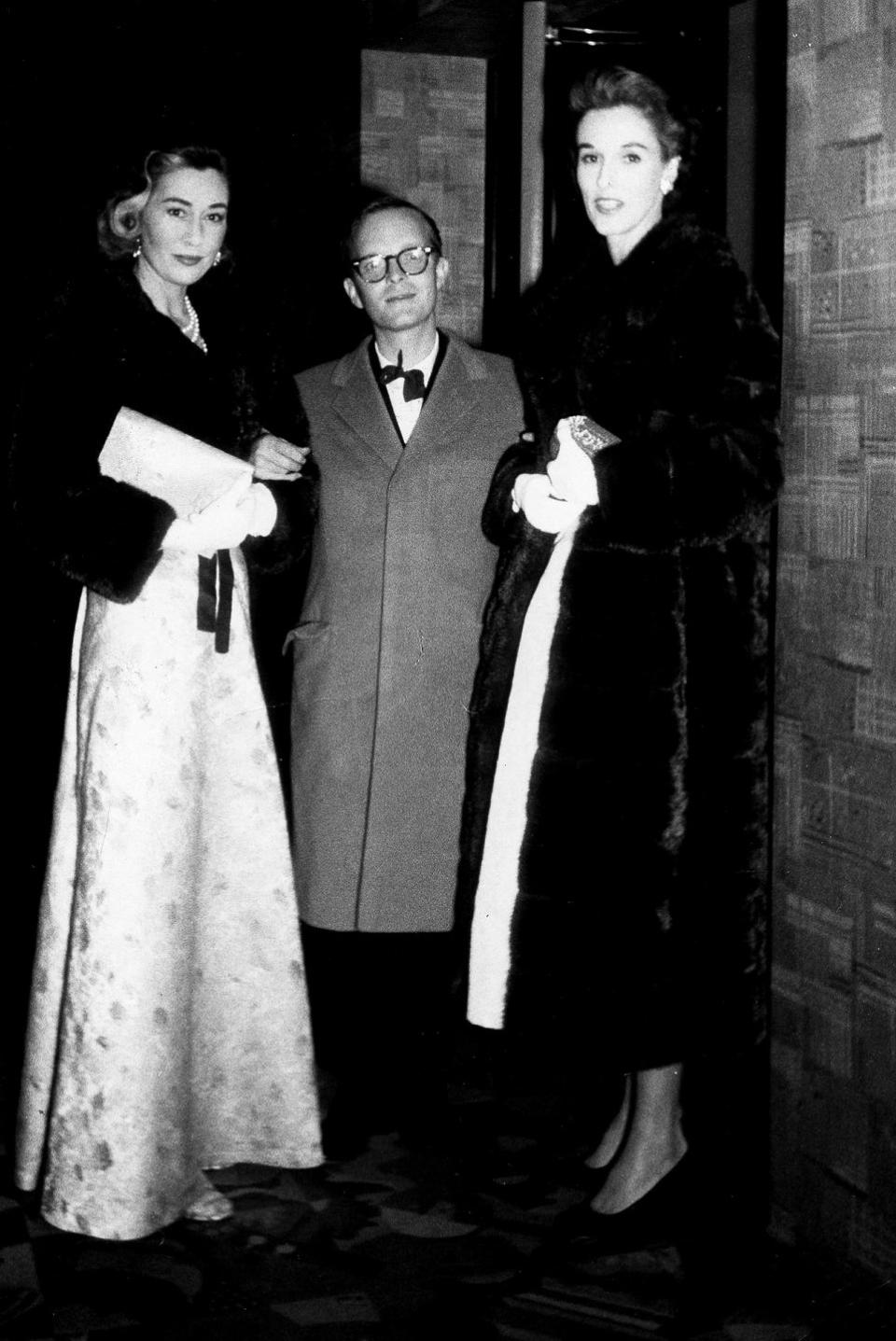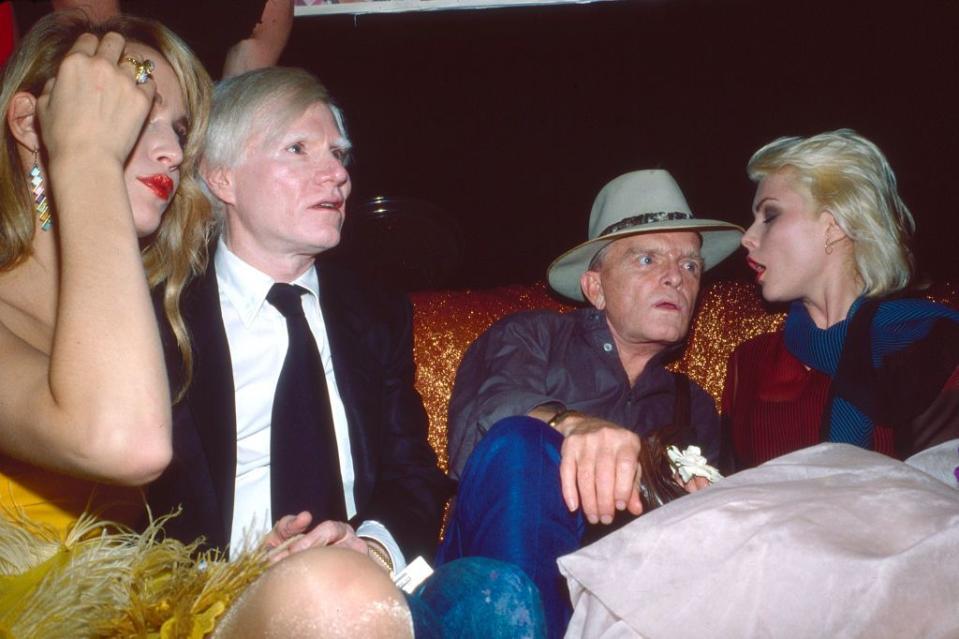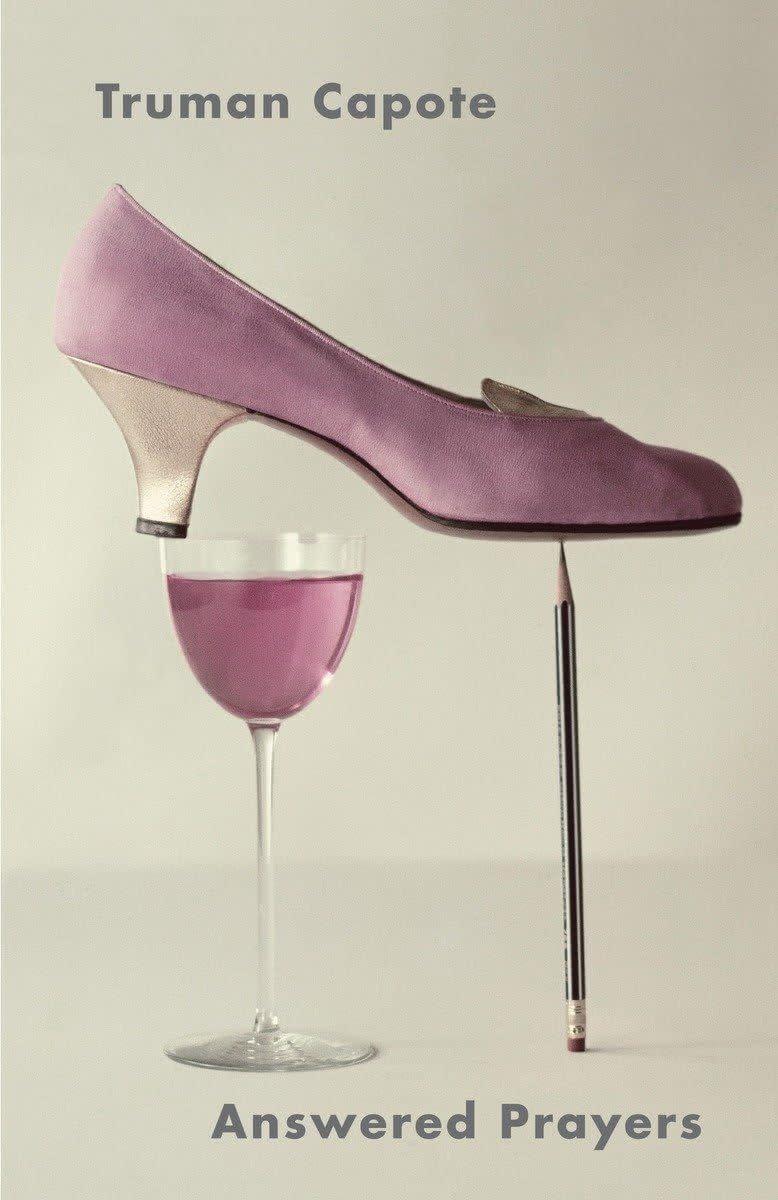Truman Capote Thought ‘Answered Prayers’ Would Be His Defining Work. Instead, It Became His Downfall

- Oops!Something went wrong.Please try again later.
- Oops!Something went wrong.Please try again later.
- Oops!Something went wrong.Please try again later.
- Oops!Something went wrong.Please try again later.
"Hearst Magazines and Yahoo may earn commission or revenue on some items through these links."
Author Truman Capote wasn’t merely relaxing on his Greek holiday in 1958, the same year his popular novella Breakfast at Tiffany’s debuted in Esquire magazine. In fact, he was already thinking about his next project—the one he thought would be his magnum opus.
“The novel is called, Answered Prayers; and, if all goes well, I think it will answer mine,” he wrote in a letter to publisher Random House. But instead of offering any sort of divine intervention, the book eventually ruined Capote’s social circle and sent the famous writer on a calamitous path toward his death.
The salacious contents of Capote’s posthumous work are at the center of the second season of the FX anthology series Feud: Capote vs. The Swans. Beginning Wednesday on FX with episodes available next-day on Hulu, it stars Tom Hollander as Capote and an ensemble cast including Naomi Watts, Diane Lane, Chloë Sevigny, Calista Flockhart, and Demi Moore.
Based on the book Capote’s Women: A True Story of Love, Betrayal, and a Swan Song for an Era by Laurence Leamer, Feud tells the story of Capote and the group of New York City socialites he befriended at the height of his popularity and affectionately called “the Swans.” But the author forever changed the course of his book—and his life—when he decided to publicize the scandalous secrets of his confidantes in the mid-1970s.
Answered Prayers was troubled from the start
While Capote seemed eager to get to work on Answered Prayers, the novel was quickly moved to the background for another project. In 1959, Capote and friend Harper Lee traveled to investigate the murders of the Clutter family in rural Kansas for an article for The New Yorker. Instead, the trip was only the beginning of a years-long saga that resulted with the publication of In Cold Blood in 1965. Capote’s full-length nonfiction crime book was a huge success. It became the best-selling book of the decade, made him a millionaire, and introduced the craft of narrative nonfiction.

By this time, Capote’s fame had helped him fully integrate among New York’s elite. He threw lavish parties and loved gossiping with his socialite friends he called the Swans. Among his primary companions were Barbara “Babe” Paley, Lee Radziwill, C.Z. Guest, Slim Keith, Marella Agnelli, and Gloria Guinness. Their interactions and shared secrets would lay the foundation for Answered Prayers—if Capote could ever get around to writing it.
In 1966, he and Random House signed a formal contract for the book. Capote received a $25,000 advance, and his due date was January 1, 1968. That deadline wasn’t met, and according to Vanity Fair, the two sides amended their agreement four more times over the next decade-plus. The financial offer for Capote eventually climbed as high as $1 million for a completed novel in 1981.
According to author Kelleigh Greenberg-Jephcott who wrote the book Swan Song, Capote was a perfectionist, sometimes rewriting dozens of pages just to change a handful of words, and prone to writer’s block. Even still, this doesn’t seem to explain his procrastination on Answered Prayers. The book felt doomed from the start, and the contents of its first three chapters sealed that fate.
Capote was warned about the book’s contents
Capote always envisioned Answered Prayers as a roman á clef, or a novel in which real people and places are disguised in fictional form. In this case, those people were his real-life friends in tales of graphic violence, sexual infidelity, drug use, and betrayal. So why would Capote risk their support publishing such a book?
For one, his success after In Cold Blood had significantly waned. He had commissions for Rolling Stone magazine that went unfiled, and his 1973 collection of nonfiction writings titled The Dogs Bark received tepid reviews. A book like Answered Prayers would certainly recapture the public’s attention for better or worse.
Capote submitted the proposed first chapter, “Mojave,” to Esquire. It published in 1975 without much controversy, even though it was apparent the subjects were Paley and her husband Bill, the founder of CBS. Although he later decided to withhold this chapter from the novel, an encouraged Capote moved forward with the next one, titled “La Côte Basque, 1965.”
Gerald Clarke, Capote’s biographer, expressed his concern that this next segment wouldn’t be received well. “I was reading it while Truman was floating in the pool on a raft. I said, ‘People aren’t going to be happy with this, Truman,’” Clarke recalled. “He said, ‘Nah, they’re too dumb. They won’t know who they are.’ He could not have been more wrong.”
The Swans quickly cut off Capote
Capote left New York City as soon as “La Côte Basque, 1965” published in Esquire’s November 1975 issue, as he began rehearsing for an upcoming film role in Los Angeles. But he couldn’t escape the swift fallout. “The minute he published that second extract in Esquire, it was like detonating a bomb,” author Greenberg-Jephcott said. “Everyone turned on him, he was a persona non grata.”
Babe Paley, who was ill with lung cancer at the time, never spoke to Capote again. According to Penguin Random House, he wasn’t invited to her funeral after she died in July 1978. Capote attempted to reach Slim Keith by telephone and cable, but she didn’t reply. She did, however, consult a lawyer about suing him for libel, according to Vanity Fair.
Most shocking of all, Ann Woodward was found dead on October 10, 1975, just days before the chapter published. According to Vanity Fair, many believed Woodward—who in 1955 shot and killed her husband, though a grand jury later deemed it an accident—had seen an advance copy of “La Côte Basque” and its interpretation of her story then died by self-inflicted poisoning.
Lee Radziwill, the younger sister of former First Lady Jacqueline Kennedy Onassis, wasn’t prominently featured and had a more muted reaction to Capote and the piece. “He was absolutely in shock... he’d say, ‘But I’m a journalist—everybody knows that I’m a journalist!’ I just don’t think he realized what he was doing, because, God, did he pay for it,” she said.
Capote also cited the artistic value of the novel as a defense, suggesting he naively assumed no one would care. “What did they expect? I’m a writer, and I use everything. Did all those people think I was there just to entertain them?” he once asked. Capote published two more chapters, “Unspoiled Monsters” and “Kate McCloud,” over the next year, but the irreparable damage was already done.
Capote spiraled after “La Côte Basque”

Now shunned by his friends and the café society they inhabited, Capote relied increasingly on drugs and alcohol to cope. According to Vanity Fair, he gained weight and spent much of his time at the famed Studio 54 nightclub, where he mingled with artist Andy Warhol, actor and singer Liza Minnelli, and others.
PBS writes that Capote abused cocaine, tranquilizers, and marijuana throughout the ’70s and had multiple stays in rehab. C.Z. Guest, who remained loyal to the author, even accompanied him to a clinic in Minnesota in 1978. But the uproar over Answered Prayers only exacerbated Capote’s struggles, and he became prone to public drunkenness and seizures.
In July 1978, Capote appeared inebriated on The Stanley Siegel Show in New York City. The host bluntly asked him, “What’s going to happen unless you lick this problem of drugs and alcohol?” Not even comprehending what he was saying, Capote grimly responded, “The obvious answer is that eventually I’ll kill myself.”
By this time, a clearly troubled Capote admitted he had stopped working on Answered Prayers, as he was “suffering a creative crisis and a personal one at the same time.” His relationship with longtime partner Jack Dunphy had deteriorated, and according to Vanity Fair, he was involved in a court dispute with another lover John O’Shea, whom he accused of running off with the manuscript for another chapter “Severe Insult to the Brain.” The suit was dropped in 1981.
The true fate of the Answered Prayers manuscript is unknown
Sick and exhausted, Capote traveled to Los Angeles in August 1984 to stay with longtime friend Joanne Carson, the second wife of late-night TV host Johnny Carson. On August 25, Carson entered her guest bedroom to find Capote struggling to breathe with a weak pulse. She said the author uttered the phrases “Beautiful Babe” and “Answered Prayers,” but he died before paramedics could arrive to help.

Answered Prayers by Truman Capote
amazon.com
$13.50
An unfinished version of Answered Prayers, which contained the three chapters previously seen in Esquire, published in the United Kingdom in 1986 and the United States a year later. However, the fate of the full version Capote originally conceptualized remains a mystery.
He had cryptically given Carson a key for an undisclosed safe-deposit box the day before his death, telling her the other chapters “will be found when they want to be found.” But, they were never discovered.
Another friend Joe Petrocik, who claimed to have seen a full manuscript from Capote, thought the writer might have stowed it away at a Greyhound bus depot during his 1978 college tour. Yet another theory is that Capote simply destroyed it after realizing the work didn’t meet his lofty expectations.
Meanwhile, biographer Clarke and others believed Capote simply abandoned the project, likely due to the backlash it generated. “Like other unfinished novels—[Charles] Dickens’ The Mystery of Edwin Drood, for example, or [F. Scott] Fitzgerald’s The Last Tycoon—the abbreviated Answered Prayers is tantalizingly incomplete. Yet, like them, it is substantial enough to be read, enjoyed and, to a limited degree, judged on its own merits,” he wrote.
In any case, the story of Answered Prayers provides a fascinating glimpse into Capote’s thoughts on friendship and social class, as well as the infamous feud it sparked.
You Might Also Like

